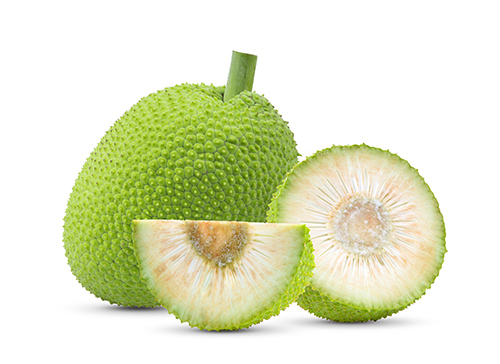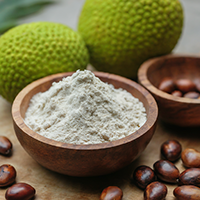Before discussing the many health benefits of breadfruit, let us investigate its history. Breadfruit became a part of history as the trigger for the mutiny on the Bounty. In 1792, this British ship carried one thousand breadfruit trees from Tahiti to the British colonies in the Caribbean, hoping they would provide abundant fruit to feed the enslaved people.
The Captain of the Bounty, Bligh, found it necessary to ration the crew’s water to provide fresh water for the freshwater needs of the trees. This fact provoked the famous mutiny that ended in the South Pacific on the solitary island of Pitcairn.

Scientific Facts
- Scientific name – Artocarpus communis Forst.
- Related species – Arctocarpus heterophylla Lam. (jackfruit).
- Other names – Breadnut, Sukun.
- French – Fruit de l’arbre â pain.
- Spanish – Fruto del pan, frutapán.
- German – Brotfrucht.
- Description – The fruit of the breadfruit, a tree of the botanical family Moraceae, reaches a height of 20 meters.
- Environment—Although initially from Southeast Asia, this tree grows wild and is cultivated in the Caribbean and Polynesian islands.
Health Benefits

The pulp is approximately seventy percent water, but once dried, its composition is like wheat flour. Wheat flour contains more protein but less fat, minerals, and vitamins than breadfruit. The case is that this fruit may be used as a substitute for wheat flour in tropical regions without bread-producing grains.

It cannot be said that this fruit is a complete food like beans or other legumes; however, it is a critical component in the diets of tropical countries. As with wheat flour, Breadfruit’s most abundant component is starch, which makes up most of its carbohydrates. Throughout digestion, starch is slowly converted into glucose, the essential energy source for the body’s cells.
How to Use and Prepare
- PULP – It is juicy and filled with fine threads. Its taste is mild and relatively neutral. It may be eaten raw or cooked, roasted, or fried.
- SEEDS – The fruit of certain breadfruit varieties contain numerous sources that are eaten roasted as if they were chestnuts.
- FLOUR – This is prepared from dried breadfruit. It is mixed with grain flour and used to make bread.
DISCLAIMER: All content on this website is presented solely for educational and informational objectives. Do not rely on the information provided as a replacement for advice, diagnosis, or treatment from a qualified medical expert. If you are pregnant, nursing, or have any preexisting medical concerns, talk to your doctor before using any herbal or natural medicines.
REFERENCES
- George D. Pamplona-Roger, M.D. “Encyclopedia of Foods and Their Healing Power.” George D. Pamplona-Roger, M.D. Encyclopedia of Foods and Their Healing Power. Trans. Annette Melgosa. Vol. 2. Chai Wan: Editorial Safeliz, 2005. 295. Print.
- https://pubmed.ncbi.nlm.nih.gov/22574842
- https://pubmed.ncbi.nlm.nih.gov/20109288
- https://hdoa.hawaii.gov/add/files/2014/05/Breadfruit-Nutrition-Fact-Sheet.pdf
- https://www.healthifyme.com/blog/breadfruit-benefits/
